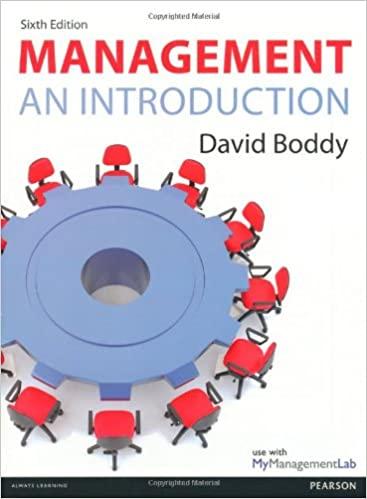Answered step by step
Verified Expert Solution
Question
1 Approved Answer
fChapter 4 ORGANIZATIONAL BEHAVIOR AND MANAGEMENT THINKING Chapter Goals Define organizational behavior Explain how management thinking affects organizational behavior Discuss examples of management thinking within
\fChapter 4 ORGANIZATIONAL BEHAVIOR AND MANAGEMENT THINKING Chapter Goals Define organizational behavior Explain how management thinking affects organizational behavior Discuss examples of management thinking within and between individuals, and within organizations Apply management thinking to communication and problem solving Apply a technique for revealing assumptions and perceptions Evolving Science of Organizational Behavior Industrial Science Administrative Management Bureaucracy Human Relations Organizational behavior is an interdisciplinary field that draws on the ideas and research of many disciplines concerned with human behavior and interaction. Organizational Behavior The study of how (and why) people behave in the workplace Draws on many other disciplines - Psychology - Social psychology - Industrial psychology - Sociology - Communications - Anthropology Organizational Behavior Occurs at Three Levels Organizational Behavior Occurs at Three Levels The most successful organizations make the best use of their employees' talents and energies (Heil, Bennis, & Stephens, 2000; Huselid, 1995). Firms that effectively manage employees hold an advantage over their competitors. Pfeffer (1998) estimates that organizations can reap a 40% gain by managing people in ways that build commitment, involvement, learning, and organizational competence. Healthcare Challenges for Organizational Behavior The Effect of Thinking on Behavior In the cognitive framework, behavior is closely tied to thinking and reasoning. We cannot understand behavior without understanding the thoughts, assumptions, and perceived attributes of a situation that precede behavior and its consequences. Cognition Mental processes of thinking include... What information is noticed How information is processed How meaning is created Mental processes for handling information control the perceptions, thinking and reasoning that behavior is based upon Mental processes for handling information are inherently limited Mental processes for handling information have predictable patterns A Cognitive Model of Organizational Behavior: The role of thinking The cognitive model of behavior highlights how thinking influences behavior Situation/Task Thinking Behavior -Interpersonal relations -Workplace cues -Problem-solving -Industry environment -Assumptions -Perceptions -Beliefs -Biases -Cognition principles -Knowledge -Reactions -Decisions -Work tasks -Learning -Adaptation Thinking Patterns Relevant to Organizational Behavior Common Individual Thinking Patterns that can Alter Understanding Assumptions: fundamental premises believed true Perceptions: what is noticed; to what attention is paid Cognitive biases: mental processing that simplifies handling information and that can compromise decision quality Common Thinking Patterns Between Individuals that can Alter Understanding Self-fulfilling prophecy: expectations about another's behavior that can elicit the expected behavior Expectancy theory: managers affect employee motivation when they influence employee expectations about ability to accomplish a task and expectations of reward Attributions: imputing the likely cause of another's behavior Attribution theory: explaining another's behavior by presuming it is caused either by a person's disposition or by the situation Mental models: beliefs about how things work Sense making: process in which organization members interpret the meaning of ambiguous Lessons from Organizational Sensemaking When organizations make sense of a situation... - How they perceive the environment defines their opportunities and constraints - Understanding is retrospective because it emerges through hindsight - Taking collective action requires sufficient understanding of a situation, though actionable, understanding may not be completely accurate Five Disciplines of Organizational Learning (Senge) Systems thinking to recognize patterns of connection Striving for individual proficiency and personal mastery Surfacing and challenging mental models A common identity and shared vision of the future Team learning that reduces assumptions and creates shared meaning NB: the last 3 disciplines counteract thinking limitations Communication in Organizations Communication: sender and receiver exchange understanding Communication barriers: arise from... sender's thinking and behavior, receiver's thinking and behavior, and from the organizational setting. Two Phases of Problem Solving in Organizations Action Inquiry to Check Assumptions Framing: state purpose and intentions Advocating: state opinion or feeling Illustrating: give supporting example Inquiring: ask for listener's views
Step by Step Solution
There are 3 Steps involved in it
Step: 1

Get Instant Access to Expert-Tailored Solutions
See step-by-step solutions with expert insights and AI powered tools for academic success
Step: 2

Step: 3

Ace Your Homework with AI
Get the answers you need in no time with our AI-driven, step-by-step assistance
Get Started


